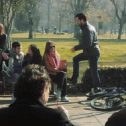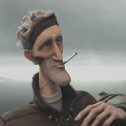"A trumpet player dives back into his memories when he was saved by Jazz."
The Journey is an exceptional short film about a trumpet player who while being onstage recalls his survival from a catastrophic moment of his life, drawing inspiration from his memories. The short was directed by six artists at French school ESMA as their graduation project, and deals with themes such as self-destruction, loss of control and music’s ability to save lives.
One main character (with a number of supporting characters), a strong internal conflict transposed into a conflict with the environment, shifting subjectivity in narration that is driven to a metaphorical level and a focus on jazz music are the main elements of The Journey (La Traversée).
Located on a theater stage and on a ship, in two different moments of the character’s life, the short employs highly metaphorical staging, with oniric (dreamlike) elements. The ship represents the character’s journey into disaster, with clear, repeated warnings of where he is headed. Yet he chooses to ignore the warning signs and walk straight into a destructive situation in order to achieve his goal, as external forces prevent him from doing so. The film’s poster points to the ship’s structure and machinery as a representation of the trumpet itself.
Narrated from the POV of the trumpet player, staging transitions from the realistic to the metaphorical and non-realistic, as narration shifts from the objective to the subjective, presenting a metaphorical flashback. The sequence of the musician playing onstage in which subjectivity transitions through pouring rain is excellent, as well as the striking image of the character playing the trumpet on the ship with a gigantic wave approaching.
Music plays an essential role throughout the film, it presents the subject, helps weave the narrative, attracts the young version of the character into a destructive situation and ends up saving his life. Its quality changes too, from the visualized version onstage, to a more occluded and distorted one being heard on the ship, which helps transmit the idea of a shift to subjective narration, while maintaining the same song being played.
Aesthetic work is impressive. The effort dedicated to materials, lighting, color palettes, composition, character and environment design shows through, as well as the fluid dynamics put to good use to potentiate the story.
Cinematography work is worth noting, too: visual rhythm is high, camera moves abound, including dollies, pans, rolls, cranes, etc. Some are used to transition from objective to subjective narration and back, such as a camera tilt plus editing in 0m41s and a quick pan and dolly in 4m29s. A cut with matching graphics in 4m58 is also used for similar purpose. The film centers on the character and its surroundings, and how he explores them, employing frequent full shots, long shots and close-ups (to help capture the expression of the character and his playing the trumpet), plus a few extreme long shots. Offscreen space is used often too, to create suspense and for reveal effect.
What makes The Journey work so well? Highly creative staging, strong story with unexpected twists, remarkable aesthetic work, a sense of authenticity that seems to point to some personal experience, great use of sensory images and intense conflicts that hook the audience.
Note: the original title of the film is “La Traversée”. As no English version was available we did our best in translating it to “The Journey”, but we must mention that this later version is not an official one. As such, please take the English version only as a possible interpretation.
Official website
Bastien Delbes's site
Delphine Espiasse's site
Evangelos Kapsopoulos's site
Guillaume Lambolez's site
Myles Jackson's site
Théo Atangana's site



















Recent Comments